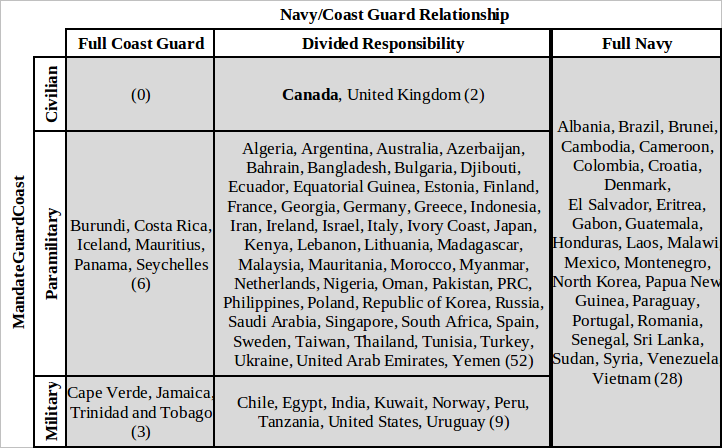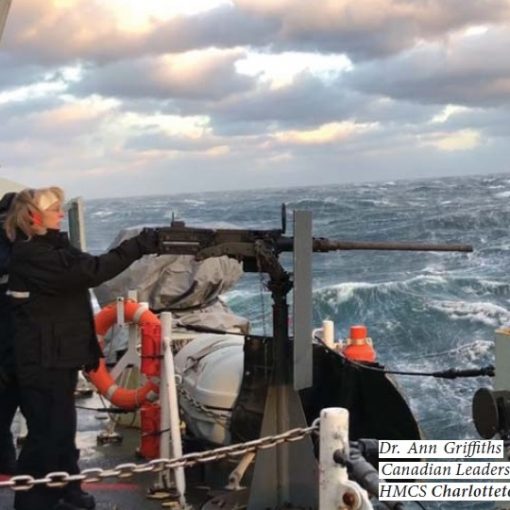The question posed in the second post in this thread by ‘R.M.’ is crucial: “Is our current multi-departmental model for domestic maritime safety/defence/enforcement the one that will meet our future requirements efficiently and effectively?” As the aforementioned Standing Senate Committee on National Security and Defence report notes [Coasts, 2007], the current approach towards maritime security in the north is puzzling. Though the Canadian navy is soon to receive ice-capable patrol ships, it has very limited ice experience and has not possessed organic ice-breaking capability since the 1950s. Meanwhile, the Canadian Coast Guard (CCG) has both a significant Arctic ‘brain trust’ and the capabilities necessary to operate in the rigours of the north, but lacks any mandate or authority to enforce Canadian law. To return to R.M.’s question, critical examination of our current model appears necessary.
The same report argues vigorously for a new maritime security responsibility to be assigned to the CCG, often citing the United States Coast Guard (USCG) as an exemplar. The position that the CCG’s responsibilities should include maritime security and law enforcement has been growing in popularity in recent years, but has not been met without objection. For example, in his editorial in the Fall 2009 issue of the Canadian Naval Review [Vol.5, No.3], Peter Haydon argues quite correctly that the transformation involved with assigning all maritime security roles to the CCG so that it better resembles the USCG would be “costly and time-consuming” (p. 3). ‘Costly’ is an understatement – the CCG’s and USCG’s expenditures per employee amount to approximately $62,000 and $180,000 respectively. To match the USCG in capabilities and capacities, the CCG’s budget would therefore likely need to increase threefold!
However, as R.M. observes, there are other models to be considered when thinking about transforming the relationship between the CCG and the Canadian navy. The Norwegian example R.M. provides is unique: the Norwegian Coast Guard is functionally and organizationally distinct, maintaining its own vessels and personnel, but it falls under the administrative umbrella of the Royal Norwegian Navy. Examples like this are useful - they help break down a false dichotomy pointing to the militarized USCG as the only alternative model to Canada’s existing civilianized coast guard.
In fact, besides the United States and Canada, there are 70 nations that have coast guards. Further, 28 nations have no coast guard at all: instead, their navies undertake many of the traditional coast guarding duties, including icebreaking, maintenance of navigational aids, search and rescue, and boater safety. The organizational relationships found between the sea services in these combined 98 other nations can be informative in scrutinizing our own multi-departmental model for domestic maritime safety/defence/enforcement.
In my recent monograph for the CFPS Maritime Security in the 21st Century Project, The Global Navy/Coast Guard Relationship: A Mandate-Based Typology, I distil from these 98 cases a typology for classifying the mandates assigned to coast guards and their relationships with navies. I argue that coast guard enforcement mandates may fall under three categories: civilian or no enforcement mandate (e.g., Canada), a paramilitary mandate, or a military mandate (e.g., the United States). The chief differences between the latter two categories are that military coast guards often possess higher-end combat capabilities, may be integrated into homeland defence planning, and may also fulfil limited expeditionary functions.
Meanwhile, the organizational relationships between navies and coast guards can be sorted under three simple headings: general maritime responsibilities are divided between the two (both navy and coast guard), full responsibility is assigned to the coast guard (no navy), or full responsibility is assigned to the navy (no coast guard). The first option is by far the most popular, and is found in both Canada and the United States. However, many examples from modern, stable societies exist in the latter two categories and are worth further examination.
The table below shows all coastal nations categorized under this typology.
Alone, this typology does not assign any ordinal rating to the various classifications; it does not propose any one category or model in favour over another. However, one thing that is immediately clear from the table above is that Canada’s existing model is almost wholly unique: the civilian coast guard, divided responsibility arrangement is found only in one other nation - the United Kingdom.
This typology demonstrates that there are numerous alternative models to consider beyond those found in Canada and in the United States. My hope is that this typology is educative as policy-makers contemplate reforming the relationship between the CCG and the navy.



